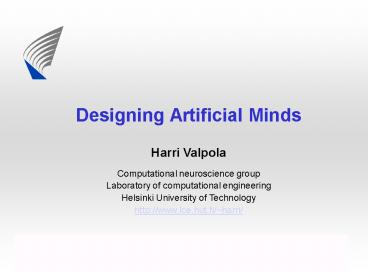Computational Neuroscience Group, LCE - PowerPoint PPT Presentation
Title:
Computational Neuroscience Group, LCE
Description:
Designing Artificial Minds Harri Valpola Computational neuroscience group Laboratory of computational engineering Helsinki University of Technology – PowerPoint PPT presentation
Number of Views:128
Avg rating:3.0/5.0
Title: Computational Neuroscience Group, LCE
1
Designing Artificial Minds
Harri Valpola
Computational neuroscience group Laboratory of
computational engineering Helsinki University of
Technology http//www.lce.hut.fi/harri/
2
- The great end of life is not knowledge but
action - Thomas Henry Huxley (1825-1895)
3
Sea Squirts Our Distant Cousins
- Sea-squirts are common marine animals
- Two stages of development larva and adult
- Larvae look very much like tadpoles
Picture http//www.jgi.doe.gov/News/ciona_4panel.
jpg
4
No Movement ? No Brain
Picture http//www.gulfspecimen.org/images/Leathe
rySeaSquirt.jpg
5
Smooth, Elegant, Skillful
Picture http//www.africanbushsafaris.com/fotos2
0touren/Oryx.jpg
Picture http//www.ebroadcast.com.au/blahdocs/upl
oads/tiger_running_sml_2784.jpg
6
Evolution of the Motor System
- Spinal cord simple reflexes and rhythmic
movement - Brain stem more complex reflexes
- Cerebellum / midbrain structures complex motor
coordination - Basal ganglia action selection
- Hippocampal formation navigation
- Neocortex integration and planning
7
Methods
- Synthetic approach learning by building
- Neural network simulations
- Real and simulated robots
8
Early Motor System
- Spinal cord simple reflexes and rhythmic
movement - Brain stem more complex reflexes
- Cerebellum / midbrain structures complex motor
coordination - Basal ganglia action selection
- Hippocampal formation navigation
- Neocortex integration and planning
9
Prediction and Anticipation
10
Adaptive Motor Control Based on a Cerebellar Model
11
Prediction and Anticipation
12
Self-Supervised Learning in Control
- Corrections are made by a large number of
reflexes (spinal cord, brain stem, cortex /
basal ganglia). - Cerebellar system learns to control using the
reflexes as teaching signals.
Picture of cerebellar system
13
Reflexes
Stretch reflex
Opto-kinetic reflex
Picture http//www.inma.ucl.ac.be/EYELAB/neurophy
sio/perception_action/vestibular_optokinetic_refle
x_fichiers/image004.jpg
Picture http//www.cs.stir.ac.uk/courses/31YF/Not
es/musstr.jpg
14
Robot Reflex
15
The Cerebellar System
Picture of cerebellar cortex
16
Long-Term Depression (LTD) Guided by Climbing
Fibres
Picture of LTD in Purkije cells
17
Vestibulo-Ocular Reflex
Picture http//www.uq.edu.au/nuq/jack/VOR.jpg
18
System-Level Computational Neuroscience
- Questions to be answered
- What kind of components are needed for a
cognitive architecture? - What are different algorithms good for and how
they can be combined? - The brain is a good solution to these questions ?
Try to - understand its algorithms on system level (level
of behaviour)
19
- Without knowledge action is useless and action
without knowledge is futile - Abu Bakr (c. 573-634)
20
Components for a Cognitive System
- Basal ganglia selection, reinforcement learning
(trial-and-error learning) - Hippocampal formation one-shot learning,
navigation, episodic memory - Neocortex
- Represents the state of the world including
oneself - Invariant representations, concepts
- Attention / selection (both sensory and motor)
- Simulation of potential worlds planning and
thinking - Relations and other structured representations
(akin to symbolic AI)
21
Neocortex
- A hierarchy of feature maps increasing levels of
abstraction - Bottom-up and top-down/lateral inputs treated
differently - Local competition
- Long-range reciprocal excitatory connections
Picture http//www.pigeon.psy.tufts.edu/avc/husba
nd/images/Isocrtx.gif
22
Representations for Natural Images by Independent
Component Analysis (ICA)
- http//www.cis.hut.fi/projects/ica/imageica/
- ICA is an example of ..unsupervised learning.
- Can learn something like .. V1 simple cells.
23
Invariant features
- Group simple features into complex in a
hierarchical model.
Picture http//cs.felk.cvut.cz/neurony/neocog/en
/images/figure3-1.gif
24
Complex Cells from Images
25
Abstractions and Meaning
26
Abstractions and Meaning
- Once we have motor output, we can learn which
information is important and meaningful
Left camera
Right camera
27
Relevance to Human Enhancement
- How about mind prostheses? New senses (like
web-sense)? - Knowing how the brain works would certainly be
useful for prostheses, but for healthy persons - Input to the brain is easiest to deliver through
existing senses content matters, not the
channel - Output from the brain through motor system is
more limited ? implanted electrodes might surpass
this capacity - I expect intelligent tools to be far more common
than prosthetic devices for a long time, but this
doesnt mean their societal impact would be any
smaller
28
Brain is a good solution for an engineering
problem
Neuroscience
Picture http//britton.disted.camosun.bc.ca/esche
r/drawing_hands.jpg
Technology
29
KIITOS! THANK YOU!































